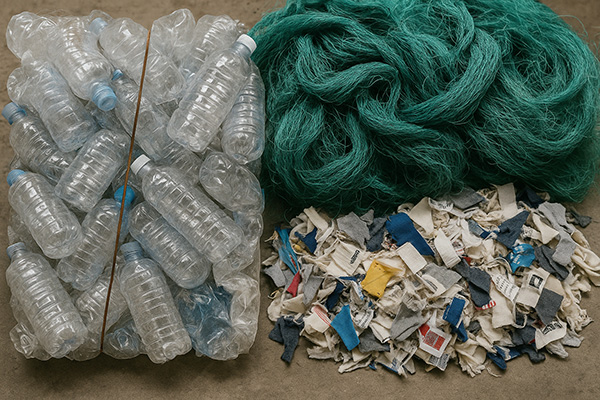13 Jun 2025
Have you heard of recycled nylon? As the concept of sustainable development becomes more important, recycled nylon fabrics are increasingly a first choice for fashion brands and their consumers. Both regular nylon and recycled nylon have their perks. So how do you choose wisely between cost and environmental impact?
So what is regular nylon? What is recycled nylon?
Nylon is a man-made fiber, plastic, and polymer widely used in textiles, outdoor gear, and industry. It is non-biodegradable and may cause environmental pollution.
Recycled nylon is a material reclaimed and reused from discarded nylon products. It can be remelted, reshaped, and made into new nylon items like textiles and plastic products.
Recycled nylon has been widely applied in areas such as bags, apparel fabrics, outdoor gear and footwear. An increasing number of international brands like Prada, Gucci, Stella McCartney and Adidas have also started using recycled nylon.

What are the differences between recycled nylon and regular nylon?
| Fabric | Recycled Nylon | Regular Nylon |
|---|---|---|
| Raw material source | Marine plastic waste, fishing nets, discarded fabrics | Petrochemical raw materials |
| Production process | Reduces oil consumption and lowers carbon emissions through closed - loop recycling | Relies on fossil fuels and generates a large amount of CO₂ during production |
| Carbon footprint | Reduces carbon emissions by 30% - 80% compared to regular nylon | About 3.2 tons of CO₂ is emitted per ton of nylon produced |
| Resource consumption | Recycles and reuses waste materials | Depends on non - renewable petroleum resources |
| Pollution risk | Chemical recycling can reduce microplastic pollution, and some products are degradable | Releases microplastic particles during production and waste is difficult to degrade |
Which is better, recycled nylon or regular nylon?
| Fabric | Recycled Nylon | Regular Nylon |
|---|---|---|
| Durability | High | High |
| Moisture absorption rate | Stable and uniform | Stable and uniform |
| Environmental certification | GRS certification | None |
| Impact on the ecosystem | Significantly reduced | High |
| Cost | Higher | Lower |
There is no significant difference in durability between recycled nylon and regular nylon. Although recycled nylon requires higher manufacturing costs, it can significantly reduce carbon emissions and further environmental pollution. In the long run, it is a cost-effective choice.

How Do We Do?
Our mission is to use high-quality, certified recyclable, organic, renewable, and innovative materials to design products our customers will love, such as Cloud Tote PTB-0146.
We firmly believe that the highest form of beauty is harmony and that a company must coexist harmoniously with society and nature. By making extensive use of innovative, distinctive materials such as recycled nylon and combining material selection with artisanal aesthetics, we aim to integrate fashion with the natural world.

The use of recycled nylon resembles a thriving tree. Its presence brings vitality to the planet and even after it withers continues to nourish new shoots in the soil. By combining recycled sustainable fabrics with continuously innovative design, we help fashion and nature to nourish each other, composing an everlasting panorama of style. We refine every product stitch by stitch so that after countless wears, it remains radiant like an evergreen tree that endures wind and rain.
True aesthetics have never meant conquering nature, but transforming its gifts into resplendent fruits.
Keywords: nylon
Originally published 13 Jun 2025, updated 13 Jun 2025.